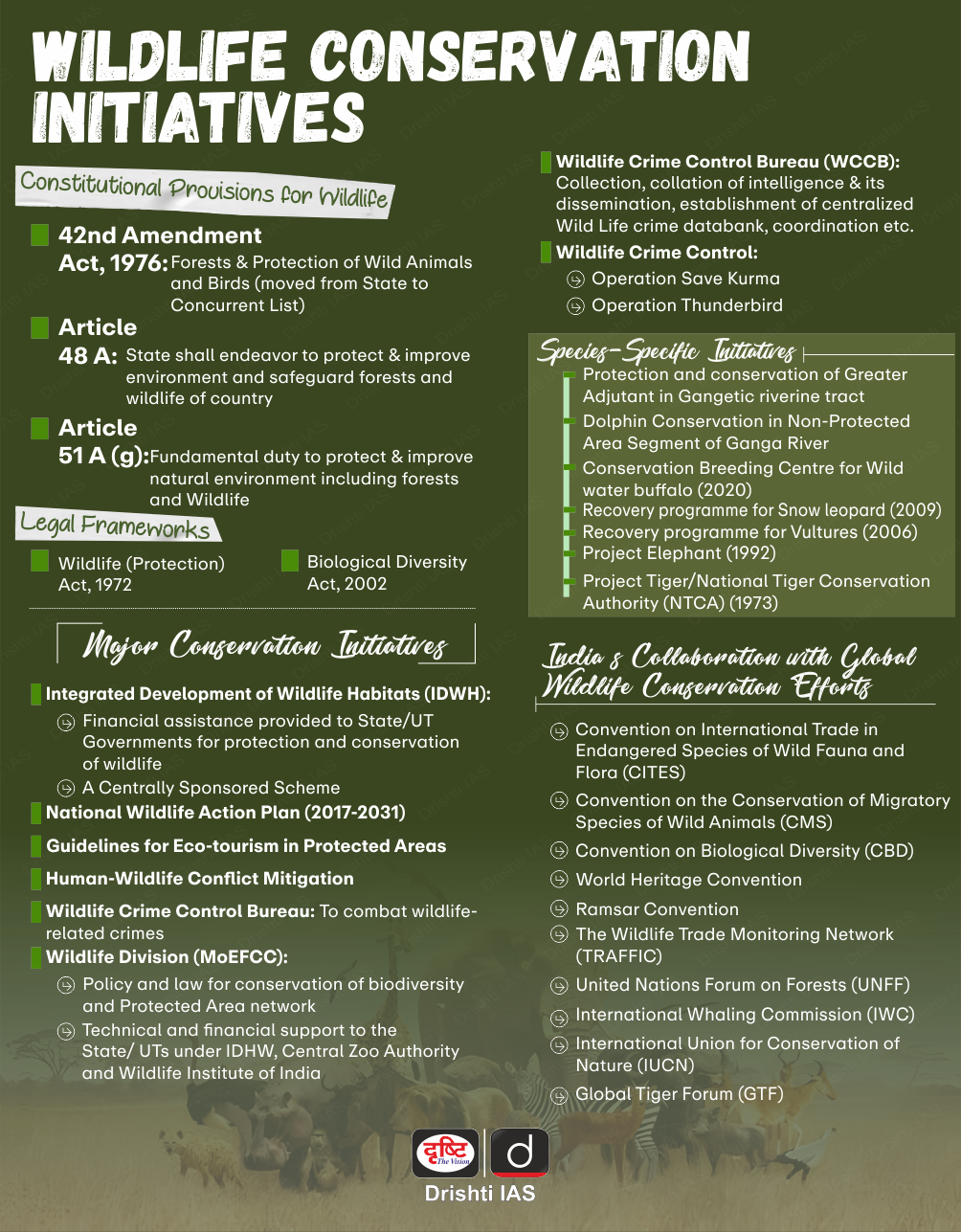Registration of Exotic Animals | 26 Aug 2024
Why in News?
Recently, the Ministry of Environment, Forest and Climate Change (MoEFCC) asked people, organisations, and zoos to register any exotic animals they have that are listed under Schedule IV of the Wild Life (Protection) Act, 1972 (Amendment Act, 2022).
- The registration must be done electronically through the PARIVESH 2.0 portal and submitted to the Chief Wildlife Warden of the respective State.
What are the Key Facts About the Exotic Species?
- About Exotic Animals:
- Exotic species are animal or plant species moved from their original range (location) to a new one. These species are introduced to a new location most often by people.
- Examples of Exotic Animals:
- Ball python (western Africa), Iguana (Central and South America), Cockatiel (Australia), Red-eared slider turtle (USA and Mexico), African grey parrot (Central Africa), Amazonian parrot (South and Central America) etc are examples of exotic animals in India.
- Legal Requirement:
- As per the Living Animal Species (Reporting and Registration) Rules, 2024, any person possessing a species listed in Schedule IV of the Wild Life (Protection) Act, 1972, must report and register the species.
- Wild Life (Protection) Amendment Act, 2022 introduced Section 49 M, requiring the registration of possession, transfer, birth, and death of species listed in the CITES Appendices and Schedule IV of the Wild Life (Protection) Act, 1972.
- Concerns with Exotic Species:
- Non-Regulation: Exotic species are imported to India and bred in captivity without proper registration which may pose a threat of zoonotic diseases.
- Impending Pandemic: The Covid-19 pandemic, a zoonotic disease, brought attention to the dangers of unregulated trade and ownership of exotic animals.
- Smuggling of Exotic Animals: Activists have raised concerns about the increased smuggling of endangered exotic animals into India from Southeast Asia and other regions.
- There has been a notable increase in the seizure of exotic animals, particularly in Assam and Mizoram, where species like Kangaroos (Australia), Koalas (Australia), and Lemurs (Madagascar) have been confiscated and temporarily housed in zoos.
What are the Key Facts About the Wild Life (Protection) Act, 1972 (WPA)?
- About WPA, 1972: It aims to protect wild animals, birds, and plants, and address related issues to ensure the ecological and environmental sustainability of the country.
- Schedules of WPA, 1972: The Wildlife (Protection) Act, 1972 has four schedules after the Wild Life (Protection) Amendment Act, 2022.
- Schedule I: For species that receive the highest level of protection. E.g., Tiger, Elephants, Rhino etc.
- Schedule II: For species that receive a lesser degree of protection. E.g., Kites, Eagle, Falcons prinias etc.
- Schedule III: For plant species
- Schedule IV: For species protected under the Convention on International Trade in Endangered Species of Wild Fauna and Flora (CITES). E.g., Bear.
- CITES is an international agreement that aims to ensure that international trade in specimens of wild animals and plants does not threaten the survival of the species.
What is the PARIVESH 2.0 Portal?
- About: PARIVESH 2.0 is a web-based application for online submission and monitoring of Environmental, Forest, Wildlife, and Coastal Regulation Zone clearances.
- PARIVESH is an acronym for Pro-Active and Responsive facilitation by Interactive, Virtuous, and Environmental Single Window Hub.
- Ministry: It has been developed by the Ministry of Environment, Forest and Climate Change (MoEFCC).
- Function: It provides a comprehensive single window solution for the administration of all green clearances and monitors their subsequent compliance across the nation.
- Process transformation, technology transformation, and domain knowledge intervention are the key drivers behind the framework of the new PARIVESH 2.0 portal.
UPSC Civil Services Examination, Previous Year Question (PYQ)
Prelims
Q. If a particular plant species is placed under Schedule VI of the Wildlife Protection Act, 1972, what is the implication? (2020)
(a) A licence is required to cultivate that plant.
(b) Such a plant cannot be cultivated under any circumstances.
(c) It is a Genetically Modified crop plant.
(d) Such a plant is invasive and harmful to the ecosystem.
Ans: (a)
Q. In India, if a species of tortoise is declared protected under Schedule I of the Wildlife (Protection) Act, 1972, what does it imply? (2017)
(a) It enjoys the same level of protection as the tiger.
(b) It no longer exists in the wild, a few individuals are under captive protection; and now it is impossible to prevent its extinction.
(c) It is endemic to a particular region of India.
(d) Both (b) and (c) stated above are correct in this context.
Ans: (a)
Q. A sandy and saline area is the natural habitat of an Indian animal species. The animal has no predators in that area but its existence is threatened due to the destruction of its habitat. Which one of the following could be that animal? (2011)
(a) Indian wild buffalo
(b) Indian wild ass
(c) Indian wild boar
(d) Indian gazelle
Ans: (b)

